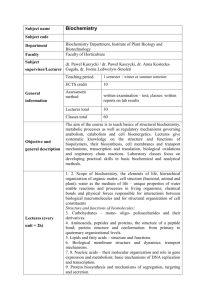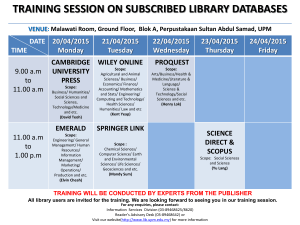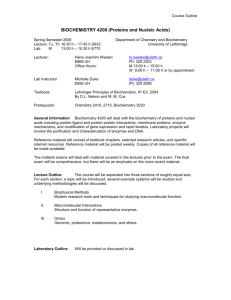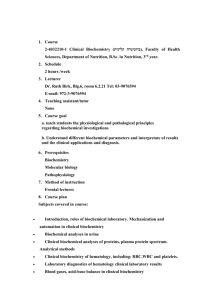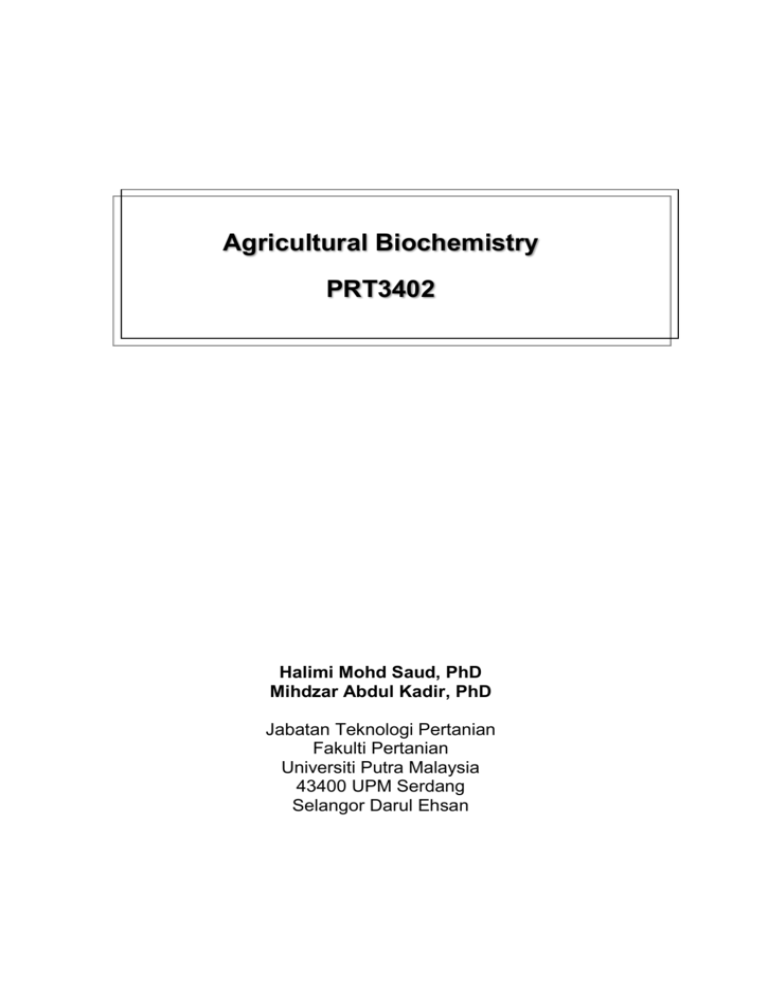
Agricultural Biochemistry
PRT3402
Halimi Mohd Saud, PhD
Mihdzar Abdul Kadir, PhD
Jabatan Teknologi Pertanian
Fakulti Pertanian
Universiti Putra Malaysia
43400 UPM Serdang
Selangor Darul Ehsan
PRT3402- Agricultural Biochemistry
UPMET
PJJ UPM /
COURSE INTRODUCTION
a. Course Information
Department
: Department of Agriculture Technology, Faculty of
Agriculture
Course
: Agricultural Biochemistry
Course code
: PRT3402
Credit hour
: 3 (2+1)
This course consists of 2 hours of lecture and three hours
of practical classes per week. A formal meeting of 6 hours
per semester with the lecturer is expected during the
semester. The schedule of formal meeting (lectures) will
be arranged by the Programme Coordinator. The students
are also required to attend practical classes at UPM for 3
weekends; in which the date and time will be arranged
and informed to the students in due course. The students
are to submit practical reports as part of the practical
classes.
b. Instructors
Name
: Halimi Mohd Saud, PhD (HMS)
Mihdzar Ab. Kadir (MAK)
Address
: Department of Agriculture Technology
Faculty of Agriculture, Universiti Putra Malaysia
43400 UPM Serdang Selangor
Telephone No. : 89474807/4808 (HMS), 89474893
E-mail
: halimi@putra.upm.edu.my (HMS)
mihdzar@agri.upm.edu.my (MAK)
ii
PRT3402- Agricultural Biochemistry
UPMET
PJJ UPM /
Course Objectives/Learning Outcomes
Students can:
1. Relate the principles of biochemistry with structure and function of
life (C4, CTPS)
2. Measure the content and components of biochemistry (P4)
3. Explain how the concepts and principles of biochemistry are the
basis of biological processes (A3)
4. Search and manage relevant information related to biochemistry
from various sources (LL)
c. Course Synopsis
This course encompasses the biochemical processes in eukaryotic
system, structure and roles of biomolecules, catalysis and control of
biochemical reactions
d. Course content
Introduction
- plant and animal cell organization
- water properties
- acid, base and buffer system
Structure and function of proteins
- amino acids
- 1o, 2o , 3o and 4o structure
- collagen, haemoglobin
Structure and functions of carbohydrates
- Structure and role of monosaccharides
- Structure and role of oligosaccharides
- Structure and role of polisaccharides
Structure and function of lipids
- Structure and chemistry of fatty acid
- Biological membranes
- Structure and role of trigliceride, phospholipid, sphingolipid, wax and terpenes
iii
PRT3402- Agricultural Biochemistry
UPMET
PJJ UPM /
Structure and functions of nucleic acids
- Structure of purines, pyrimidines, DNA and RNA
- Structure and organization of genome
- process and regulation of transcription and translation
Catalysis and regulation of biochemical reactions
- Characteristics, classification and kinetics of an enzyme
- Enzyme inhibition and regulation
Metabolism and generation of ATP
- Metabolism and their regulation
- Glycolysis and their regulation
- Citric acid cycle and its regulation
- Mitochondria structure and oxidative phosphorylation
Carbohydrate metabolism
- Introduction to bioenergetics
- Glycolysis and fermentation
- Citric acid or tricarboxylic acid cyle
- Electron transport system
Photosynthesis
- Light and leaf
- Light dependent and light independent (dark) reactions
Hormones and plant growth regulators
- Hormones, glands and classes of hormones
- Plant growth hormones, plant growth regulators and phytohormones
e. Guidelines for assignments
All assignments (including laboratory reports) will be announced to the
students via email or during face-to-face meeting. This assignment must be
type written on A4 size paper with Arial font of size 12 with 1.5 spacing.
Usually the assignment is not more than 10 pages including any
references. The assignments must be bound properly and submitted by the
date due. Details of assignments or reports will be communicated to the
students.
iv
PRT3402- Agricultural Biochemistry
UPMET
PJJ UPM /
Table 1. Unit Title (Lecture) and Suggested Allocated Lecture Hours
Unit
Suggested
Allocation of
Hours**
Title
1
Introduction to basic biochemistry
12
2
Structure and function of amino acids and protein
9
3
Structure and
carbohydrates
4
Structure and function of lipids
9
5
Structure and function of nucleic acids
9
6
Catalysis and regulation of biochemical reactions
12
7
Metabolism and generation of ATP
12
8
Photosynthesis
6
9
Hormones and plant growth regulators
6
function
of
saccharides
and
9
** Virtual Learning: One hour of lecture is equivalent to three hours of
self- learning
v
PRT3402- Agricultural Biochemistry
UPMET
PJJ UPM /
g. Course Evaluation
Course evaluation will be divided as follows:
(i)
Overall coursework
Group Assignments
Individual Practical Reports
20%
(ii)
Midterm tests (Test 1 + Test 2)
40%
(ii)
Final exam
40%
Total
100%
10%
10%
** Course evaluation may change from time to time according to the
current instructor/lecturer.
Suggested Timetable and Learning Activities
1. Face-to-face meeting
8 hours
2. Self learning
70 hours
3. Tutorial (4-6 sessions)
12 hours
4. Group Study
10 hours
5. Online/Email/Telephone/
PutraLMS/Virtual Class
5 hours
6. Quizzes
5 hours
7. Assignments/Practical Classes
and Reports
10 hours
Total Learning Hours
120 hours
vi
PRT3402- Agricultural Biochemistry
UPMET
PJJ UPM /
h. Test 1 and Test 2
All students are required to take Test 1 and Test 2 during the semester.
Test 1 will cover Units 1-4 and Test 2 will cover Units 5-7. All questions
will be based on the module. Questions can be in objectives, shortanswers, subjective or essay types or a combination of all types. The
instructor will inform the students the actual format of the tests during the
face-to-face meeting. Tests will be conducted over a two-hour period.
i. Final examination
Final exam questions will cover all lecture topics but emphasis will be on
topics not covered in Test 1 and Test 2 (i.e. Units 8, 9 and 10). The
lecturer/instructor will inform the students the topics that will be covered in
the final exam for that particular semester. The format of the questions will
be similar to Test 1 and Test 2. Any changes to the format will be informed
by the instructor during the face-to-face meeting. Final examination is
conducted over a two-hour period.
j. Main references
Acquaah, G. (2004). Understanding Biotechnology. Upper Saddle River:
Pearson Prentice Hall.
Bowsher, C., Steer, M. & Tobin, A. (2008). Plant Biochemistry. New York :
Garland Science
Campbell, M.K. & Farrell, S.O. (2006). Biochemistry (5th Edition). Belmont:
Thomson Brooks/Cole.
Farrell, S.O. & Taylor, L.E. (2006). Experiments in Biochemistry : A Handson Approach (2nd Edition). Belmont: Thompson Brook/Cole.
Watson, J.D., Baker, T.A., Bell, S.P., Gann, A., Levine, M., Losick, R. &
Inglis, C.S.H. (2007). Molecular Biology of the Gene (6th Edition). San
Francisco: Pearson Benjamin Cummings.
vii
PRT3402- Agricultural Biochemistry
UPMET
PJJ UPM /
k. Additional References
Mathews, C.K., van Holde, K.E., Appling D.R. & S. J. Anthony Cahill (2012).
Biochemistry 4th Edition. New York, Prentice-Hall.
Clark D. (2010). Molecular Biology. Academic Cell Update. New York,
Elsevier
viii
PRT3402- Agricultural Biochemistry
UPMET
PJJ UPM /
l. Description of the icons used in this module
Several icons are used in this module to help students to understand
better the content and subject of this course. The icons and their
meanings are listed below:
a)
Objective
Module, unit or topic objective
b)
Introduction
Introduction to unit, topic or sub-topic
c)
Main points
A group of main points in atopic or unit
d)
Observation/
View
Observation or view from researchers through
research
e)
Conclusion
Conclusion made on a topic or unit that has
been learned
f)
Questions in
the text
Questions in the text posed by the writer while
discussing the topic
g)
Self evaluation
questions
Questions by the writer to help student to
evaluate their understanding of the topic
discussed
h)
Checking
answers to
exercise
questions
Answers to exercises prepared for each unit or
topic
i)
References
References that can be used as additional guide
to the course or topic
Attention
This symbol is used to any points that students
must pay close attention
j)
ix
PRT3402- Agricultural Biochemistry
UPMET
PJJ UPM /
Lecture Contents
Unit
1
Title
Introduction to basic biochemistry
Page
No.
1
Topic 1: Cell organization
Topic 2: Water, bonding and its interactions
Topic 3: Acid, base, pH and buffers
2
Structure and function of amino acids and proteins
19
Topic 1: Structure of amino acids, peptides and polypeptides
Topic 2: Structure and types of proteins
3
Structure and function saccharides and carbohydrates
Topic 1: Structure of saccharides, stereoisomers,
oligosaccharides and their derivatives
33
Topic 2: Structure and function of polysaccharides
4
Structure and function of lipids
51
Topic 1: Structure and chemical properties of fatty acids and its
derivatives
Topic 2: Biological membranes
Topic 3: Structure and role of triglycerides and phospholipids
Topic 4: Structure and role of sphingolipids, wax, terpenes and
steroids
5
Structure and function of nucleic acids
67
Topic 1: Structure of purines, pyrimidines, DNA and RNA
Topic 2: DNA replication and gene expression: transcription and
translation
Topic 3: Genome structure, organization and function
6
Catalysis and regulation of biochemical reactions
85
Topic 1: Characteristics, classification and kinetics of an enzyme
Topic 2: Enzyme inhibition and regulation
7
Metabolism and generation of ATP
101
Topic 1: Metabolism and their regulation
Topic 2: Glycolysis and their regulation
Topic 3: Citric acid cycle and its regulation
Topic 4: Mitochondria structure and oxidative phosphorylation
8
1
Photosynthesis
Topic 1: Light and leaf
Topic 2: Light dependent and light independent (dark) reactions
9
Hormones and plant growth regulators
Topic 1: Hormones, glands and classes of hormones
Topic 2: Plant growth hormones, plant growth regulators and
phytohormones
x


